
Zirconium dioxide, sometimes known as zirconia, is a white crystalline oxide of zirconium. Its most naturally occurring form, with a monoclinic crystalline structure, is the mineral baddeleyite. A dopant stabilized cubic structured zirconia, cubic zirconia, is synthesized in various colours for use as a gemstone and a diamond simulant.
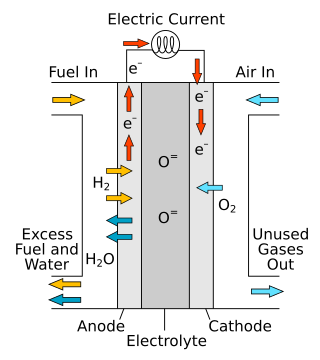
A solid oxide fuel cell is an electrochemical conversion device that produces electricity directly from oxidizing a fuel. Fuel cells are characterized by their electrolyte material; the SOFC has a solid oxide or ceramic electrolyte.
A trioxide is a compound with three oxygen atoms. For metals with the M2O3 formula there are several common structures. Al2O3, Cr2O3, Fe2O3, and V2O3 adopt the corundum structure. Many rare earth oxides adopt the "A-type rare earth structure" which is hexagonal. Several others plus indium oxide adopt the "C-type rare earth structure", also called "bixbyite", which is cubic and related to the fluorite structure.
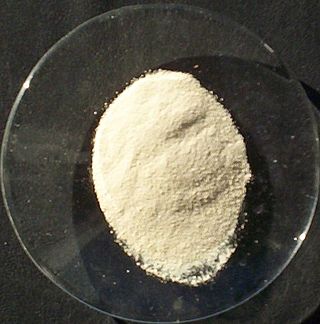
Cerium(IV) oxide, also known as ceric oxide, ceric dioxide, ceria, cerium oxide or cerium dioxide, is an oxide of the rare-earth metal cerium. It is a pale yellow-white powder with the chemical formula CeO2. It is an important commercial product and an intermediate in the purification of the element from the ores. The distinctive property of this material is its reversible conversion to a non-stoichiometric oxide.
Solid oxygen forms at normal atmospheric pressure at a temperature below 54.36 K (−218.79 °C, −361.82 °F). Solid oxygen O2, like liquid oxygen, is a clear substance with a light sky-blue color caused by absorption in the red part of the visible light spectrum.
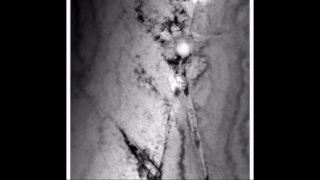
Zirconium hydride describes an alloy made by combining zirconium and hydrogen. Hydrogen acts as a hardening agent, preventing dislocations in the zirconium atom crystal lattice from sliding past one another. Varying the amount of hydrogen and the form of its presence in the zirconium hydride controls qualities such as the hardness, ductility, and tensile strength of the resulting zirconium hydride. Zirconium hydride with increased hydrogen content can be made harder and stronger than zirconium, but such zirconium hydride is also less ductile than zirconium.

Curium(III) oxide is a compound composed of curium and oxygen with the chemical formula Cm2O3. It is a crystalline solid with a unit cell that contains two curium atoms and three oxygen atoms. The simplest synthesis equation involves the reaction of curium(III) metal with O2−: 2 Cm3+ + 3 O2− ---> Cm2O3. Curium trioxide can exist as five polymorphic forms. Two of the forms exist at extremely high temperatures, making it difficult for experimental studies to be done on the formation of their structures. The three other possible forms which curium sesquioxide can take are the body-centered cubic form, the monoclinic form, and the hexagonal form. Curium(III) oxide is either white or light tan in color and, while insoluble in water, is soluble in inorganic and mineral acids. Its synthesis was first recognized in 1955.
Beta-alumina solid electrolyte (BASE) is a fast ion conductor material used as a membrane in several types of molten salt electrochemical cell. Currently there is no known substitute available. β-Alumina exhibits an unusual layered crystal structure which enables very fast ion transport. β-Alumina is not an isomorphic form of aluminium oxide (Al2O3), but a sodium polyaluminate. It is a hard polycrystalline ceramic, which, when prepared as an electrolyte, is complexed with a mobile ion, such as Na+, K+, Li+, Ag+, H+, Pb2+, Sr2+ or Ba2+ depending on the application. β-Alumina is a good conductor of its mobile ion yet allows no non-ionic (i.e., electronic) conductivity. The crystal structure of the β-alumina provides an essential rigid framework with channels along which the ionic species of the solid can migrate. Ion transport involves hopping from site to site along these channels. Since the 1970's this technology has been thoroughly developed, resulting in interesting applications. Its special characteristics on ion and electrical conductivity make this material extremely interesting in the field of energy storage.
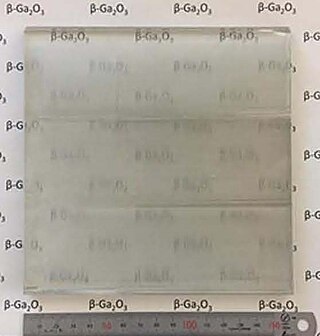
Gallium(III) oxide is an inorganic compound and ultra-wide-bandgap semiconductor with the formula Ga2O3. It is actively studied for applications in power electronics, phosphors, and gas sensing. The compound has several polymorphs, of which the monoclinic β-phase is the most stable. The β-phase’s bandgap of 4.7–4.9 eV and large-area, native substrates make it a promising competitor to GaN and SiC-based power electronics applications and solar-blind UV photodetectors. The orthorhombic ĸ-Ga2O3 is the second most stable polymorph. The ĸ-phase has shown instability of subsurface doping density under thermal exposure. Ga2O3 exhibits reduced thermal conductivity and electron mobility by an order of magnitude compared to GaN and SiC, but is predicted to be significantly more cost-effective due to being the only wide-bandgap material capable of being grown from melt. β-Ga2O3 is thought to be radiation-hard, which makes it promising for military and space applications.
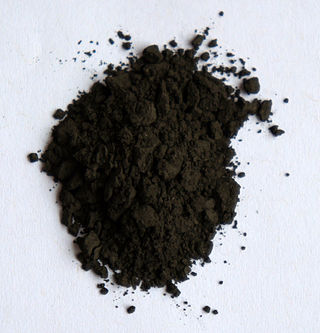
Titanium hydride normally refers to the inorganic compound TiH2 and related nonstoichiometric materials. It is commercially available as a stable grey/black powder, which is used as an additive in the production of Alnico sintered magnets, in the sintering of powdered metals, the production of metal foam, the production of powdered titanium metal and in pyrotechnics.

The element sulfur exists as many allotropes. In number of allotropes, sulfur is second only to carbon. In addition to the allotropes, each allotrope often exists in polymorphs delineated by Greek prefixes.

Yttria-stabilized zirconia (YSZ) is a ceramic in which the cubic crystal structure of zirconium dioxide is made stable at room temperature by an addition of yttrium oxide. These oxides are commonly called "zirconia" (ZrO2) and "yttria" (Y2O3), hence the name.

Solid-state ionics is the study of ionic-electronic mixed conductor and fully ionic conductors and their uses. Some materials that fall into this category include inorganic crystalline and polycrystalline solids, ceramics, glasses, polymers, and composites. Solid-state ionic devices, such as solid oxide fuel cells, can be much more reliable and long-lasting, especially under harsh conditions, than comparable devices with fluid electrolytes.
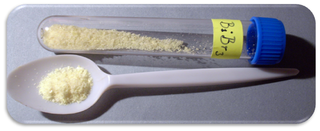
Bismuth tribromide is an inorganic compound of bismuth and bromine with the chemical formula BiBr3.
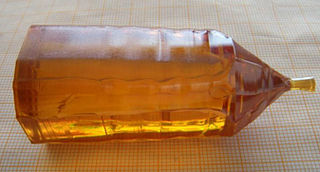
Bismuth silicon oxide is a solid inorganic compound of bismuth, silicon and oxygen. Its most common chemical formula is Bi12SiO20, though other compositions are also known. It occurs naturally as the mineral sillénite and can be produced synthetically, by heating a mixture of bismuth and silicon oxides. Centimeter-sized single crystals of Bi12SiO20 can be grown by the Czochralski process from the molten phase. They exhibit piezoelectric, electro-optic, elasto-optic, photorefractive and photoconductive properties, and therefore have potential applications in spatial light modulators, acoustic delay lines and hologram recording equipment. Bi12SiO20 can be obtained as a whitish powder with band gap of approximately 3.2 eV starting from bismuth subcarbonate and silica in presence of ethyleneglycol. 29Si solid-state NMR is used to proof that the Si(IV) cations are sharing oxygen atoms with the Bi(III) cations. The 29Si chemical shift (δ) in Bi12SiO20 is −78.1 ppm. Unlike the bismuth oxide, the presence of the acidic Si(IV) cations avoid the reactivity with CO2.

Caesium bisulfate or cesium hydrogen sulfate is an inorganic compound with the formula CsHSO4. The caesium salt of bisulfate, it is a colorless solid obtained by combining Cs2SO4 and H2SO4.

Sillénite or sillenite is a mineral with the chemical formula Bi12SiO20. It is named after the Swedish chemist Lars Gunnar Sillén, who mostly studied bismuth-oxygen compounds. It is found in Australia, Europe, China, Japan, Mexico and Mozambique, typically in association with bismutite.

Bismuth titanate or bismuth titanium oxide is a solid inorganic compound of bismuth, titanium and oxygen with the chemical formula of Bi12TiO20, Bi 4Ti3O12 or Bi2Ti2O7.

Lithium iridate, Li2IrO3, is a chemical compound of lithium, iridium and oxygen. It forms black crystals with three slightly different layered atomic structures, α, β, and sometimes γ. Lithium iridate exhibits metal-like, temperature-independent electrical conductivity, and changes its magnetic ordering from paramagnetic to antiferromagnetic upon cooling to 15 K.
Lithium lanthanum zirconium oxide (LLZO, Li7La3Zr2O12) or lithium lanthanum zirconate is a lithium-stuffed garnet material that is under investigation for its use in solid-state electrolytes in lithium-based battery technologies. LLZO has a high ionic conductivity and thermal and chemical stability against reactions with prospective electrode materials, mainly lithium metal, giving it an advantage for use as an electrolyte in solid-state batteries. LLZO exhibits favorable characteristics, including the accessibility of starting materials, cost-effectiveness, and straightforward preparation and densification processes. These attributes position this zirconium-containing lithium garnet as a promising solid electrolyte for all-solid-state lithium-ion rechargeable batteries.



















